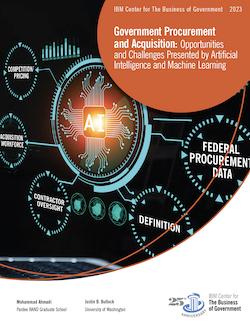
Using Artificial Intelligence to Improve Procurement

The federal government spends more than $500 billion in the acquisition of goods and services annually. However, agencies face enduring challenges in modernizing the procurement process to support mission achievement, including requirements definition, competition, pricing, contractor oversight, federal procurement data, acquisition workforce, and small business participation.
A new IBM Center report, Using AI to Improve Government Procurement: Challenges and Opportunities, by Justin Bullock at the University of Washington and Mohammed Ahmadi at the Pardee Rand Graduate School, addresses using artificial intelligence to transform public procurement, analyzing challenges and recommending ways to capitalize on opportunities. These challenges, consistent with Government Accountability office findings, include requirements definition, competition and pricing, contractor oversight, procurement data, and the acquisition workforce.
For each challenge, the report presents a potential opportunity for AI too ls to assist. AI can potentially aid by improving the specification of procurement requirements using recommendation algorithms, improving competition and pricing of goods for procurement through natural language models, using computer vision and machine learning (ML) to assist with contractor oversight, automating capture of federal procurement data, and improving task performance through automation of standard intake forms. The authors also present use cases that illustrate models for such opportunities.
The report makes recommendations about how to use AI to transform public procurement, which can increase speed, efficiency, and effectiveness in acquiring goods and services that serve public needs by fostering facilitating intelligent automation across the federal acquisition system. The recommendations point to action in multiple areas, including:
- building out a maturity model of AI integration within the organization, as part of a strategic plan for the use of AI,
- ensuring that the AI models are built upon a strong, quality data foundation,
- working to build organizational capacity to integrate AI and automation tools to the procurement process,
- getting support for adequate resources as key to the success or failure of integrating these tools into the procurement process,
- carefully managing which sorts of tasks are suited to the use of AI tools for procurement, and
- systematically ensuring that bias is not increased as a part of adoption.
This report builds on multiple Center reports focused on using AI and automation to improve procurement and other government systems, including Artificial Intelligence in the Public Sector: A Maturity Model, Improving Outcomes in Government Through Data and Intelligent Automation, Risk Management in the AI Era, and The Future Has Begun: Using Artificial Intelligence to Transform
Government.
The report also continues our ongoing efforts to develop improvement ideas for acquisition more broadly, most recently including Other Transactions Authorities: After 60 Years, Hitting Their Stride or Hitting the Wall and Buying As One: Category Management Lessons from the United Kingdom.
We hope that government procurement leaders and stakeholders find the report helpful in leveraging AI to improve the critically important process of acquiring goods and service to carry out agency missions



